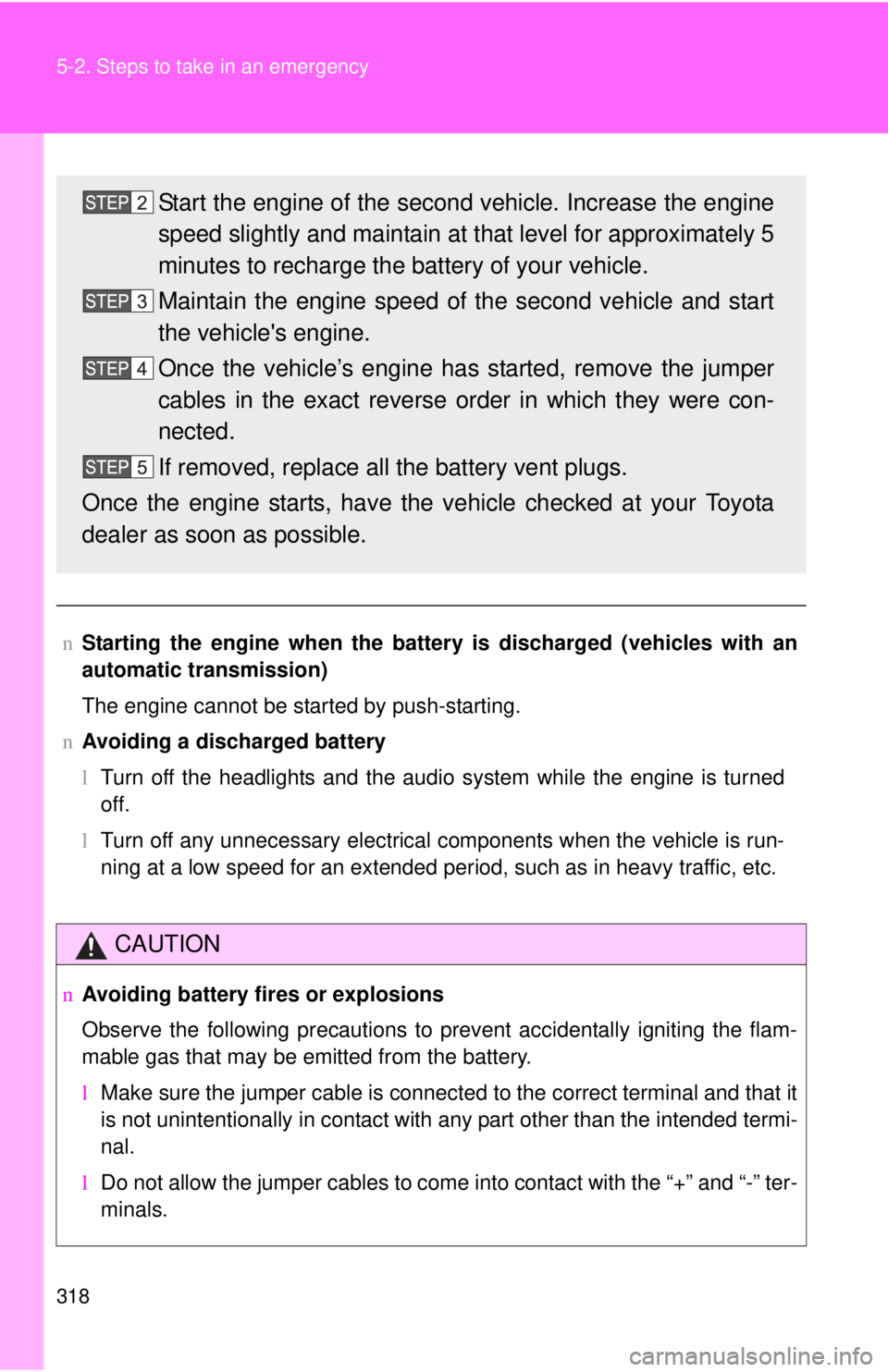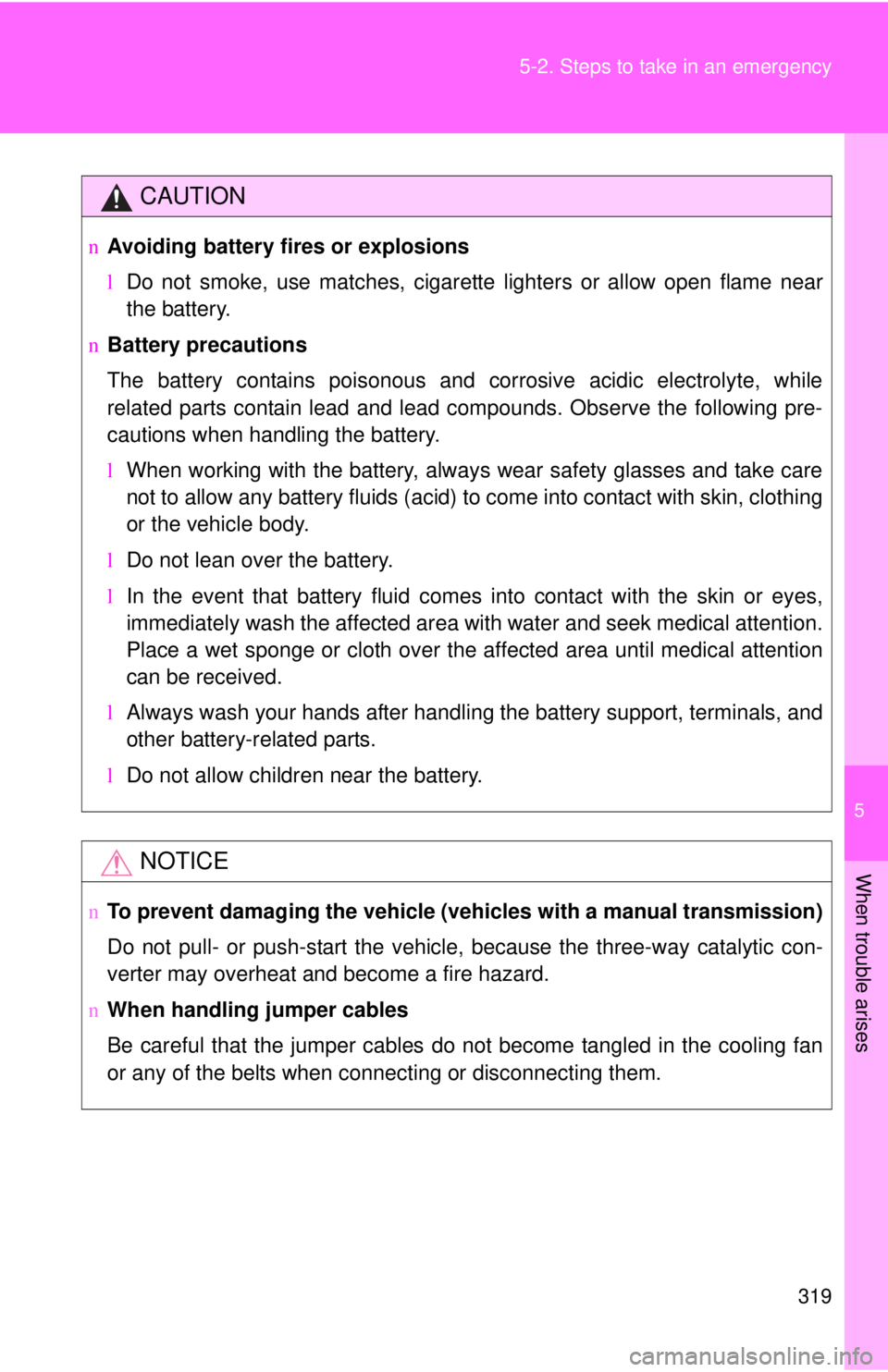Page 268 of 384
255
4-3. Do-it-yourself maintenance
4
Maintenance and care
Key batter y
Replace the battery with a new one if it is discharged.
nYou will need the following items:
lFlathead screwdriver (To prevent damage to the key, cover
the tip of the screwdriver with plastic tape.)
l Lithium battery CR2016
n Replacing the battery
Remove the cover.
Remove the module.
Remove the battery cover and
the depleted battery.
Insert a new battery with the
“+” terminal facing up.
Page 269 of 384
256 4-3. Do-it-yourself maintenance
nIf the key battery is discharged
The following symptoms may occur.
lThe wireless remote control will not function properly.
l The operational range is reduced.
n Use a CR2016 lithium battery
lBatteries can be purchased at your Toyota dealer, jewelers, or camera
stores.
l Replace only with the same or equivalent type recommended by your
Toyota dealer.
l Dispose of used batteries according to the local laws.
CAUTION
nRemoved battery and other parts
Keep away from children.
These parts are small and if swallowed by a child they can cause choking.
NOTICE
nFor normal operation after replacing the battery
Observe the following precautions to prevent accidents.
lAlways work with dry hands.
Moisture may cause the battery to rust.
l Do not touch or move any other components inside the remote control.
l Do not bend either of the battery terminals.
Page 325 of 384
5
When trouble arises
313
5-2. Steps to take in an emergency
If the engine will not start
If the engine still does not start after following the correct starting
procedure ( →P. 108) or releasing the steering lock (→P. 108), confirm
the following points.
n The engine will not start even when the starter motor oper-
ates normally.
One of the following may be the cause of the problem.
lThere may not be sufficient fuel in the vehicle’s tank.
Refuel the vehicle.
l The engine may be flooded.
Try to restart the engine once more following correct starting
procedures.
l Vehicles with engine immobilizer system: There may be a
malfunction in the engine immobilizer system.
( → P. 5 9 )
n The starter motor turns over slowly, the interior lights and
headlights are dim, or the horn does not sound or sounds at
a low volume.
One of the following may be the cause of the problem.
lThe battery may be discharged. ( →P. 317)
l The battery terminal connec tions may be loose or corroded.
Page 326 of 384
314 5-2. Steps to take in an emergency
nThe starter motor does not turn over, the interior lights and
headlights do not turn on, or the horn does not sound.
One of the following may be the cause of the problem.
l One or both of the battery terminals may be disconnected.
l The battery may be discharged. ( →P. 317)
Contact your Toyota dealer if the problem cannot be repaired, or if
repair procedures are unknown.
Page 329 of 384
5
When trouble arises
317
5-2. Steps to take in an emergency
If the vehicle batter y is discharged
The following procedures may be used to start the engine if the
vehicle's battery is discharged.
You can call your Toyota dealer or qualified repair shop.
If you have a set of jumper (or boo ster) cables and a second vehi-
cle with a 12-volt battery, you can jump start your Toyota following
the steps below.
Connecting the jumper cables
If required, remove all vent plugs from the booster and dis-
charged batteries. Lay a cloth ov er the open vents on the batter-
ies. (This helps reduce the explosion hazard, personal injuries
and burns.)
Positive (+) battery terminal on your vehicle
Positive (+) battery terminal on the second vehicle
Negative (-) battery terminal on the second vehicle
Connect the jumper cable to ground on your vehicle as shown in
the illustration.
Page 330 of 384

318 5-2. Steps to take in an emergency
nStarting the engine when the battery is discharged (vehicles with an
automatic transmission)
The engine cannot be started by push-starting.
n Avoiding a discharged battery
lTurn off the headlights and the audio system while the engine is turned
off.
l Turn off any unnecessary electrical components when the vehicle is run-
ning at a low speed for an extended period, such as in heavy traffic, etc.
CAUTION
nAvoiding battery fires or explosions
Observe the following precautions to prevent accidentally igniting the flam-
mable gas that may be emitted from the battery.
lMake sure the jumper cable is connected to the correct terminal and that it
is not unintentionally in contact with any part other than the intended termi-
nal.
l Do not allow the jumper cables to come into contact with the “+” and “-” ter-
minals.
Start the engine of the second vehicle. Increase the engine
speed slightly and maintain at that level for approximately 5
minutes to recharge the battery of your vehicle.
Maintain the engine speed of the second vehicle and start
the vehicle's engine.
Once the vehicle’s engine has started, remove the jumper
cables in the exact reverse order in which they were con-
nected.
If removed, replace all the battery vent plugs.
Once the engine starts, have the vehicle checked at your Toyota
dealer as soon as possible.
Page 331 of 384

5
When trouble arises
319
5-2. Steps to take in an emergency
CAUTION
n
Avoiding battery fires or explosions
lDo not smoke, use matches, cigarette lighters or allow open flame near
the battery.
n Battery precautions
The battery contains poisonous and corrosive acidic electrolyte, while
related parts contain lead and lead compounds. Observe the following pre-
cautions when handling the battery.
lWhen working with the battery, always wear safety glasses and take care
not to allow any battery fluids (acid) to come into contact with skin, clothing
or the vehicle body.
l Do not lean over the battery.
l In the event that battery fluid comes into contact with the skin or eyes,
immediately wash the affected area with water and seek medical attention.
Place a wet sponge or cloth over the affected area until medical attention
can be received.
l Always wash your hands after handling the battery support, terminals, and
other battery-related parts.
l Do not allow children near the battery.
NOTICE
nTo prevent damaging the vehicle (vehicles with a manual transmission)
Do not pull- or push-start the vehicle, because the three-way catalytic con-
verter may overheat and become a fire hazard.
n When handling jumper cables
Be careful that the jumper cables do not become tangled in the cooling fan
or any of the belts when connecting or disconnecting them.
Page 342 of 384
331
6-1. Specifications
6
Vehicle specifications
Electrical system
Automatic transaxle
Manual transaxle
Battery
Open voltage at
68°
F (20 °C): 12.6 ⎯ 12.8 V Fully charged
12.2 ⎯ 12.4 V Half charged
11 . 8
⎯ 12.0 V Discharged
(Voltage checked 20 minutes after
the key is removed with all the lights
turned off)
Charging rates 5 A max.
Fluid capacity
(Drain and refill)2.6 qt. (2.5 L, 2.2 Imp.qt.)
Fluid type
Toyota Genuine ATF WS
NOTICE
nAutomatic transmission fluid type
Using automatic transmission fluid other than “Toyota Genuine ATF WS”
may cause deterioration in shift quality, locking up of your transmission
accompanied by vibration, and ultimately damage the automatic transmis-
sion of your vehicle.
Gear oil capacity (Reference) 2.0 qt. (1.9 L, 1.7 Imp.qt.)
Gear oil type Gear oil API GL-4 or GL-5
Recommended gear oil
viscosity SAE 75W-90